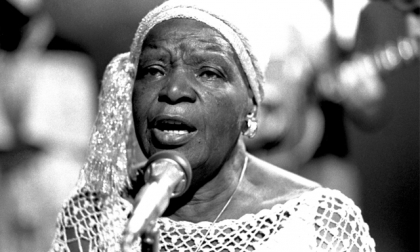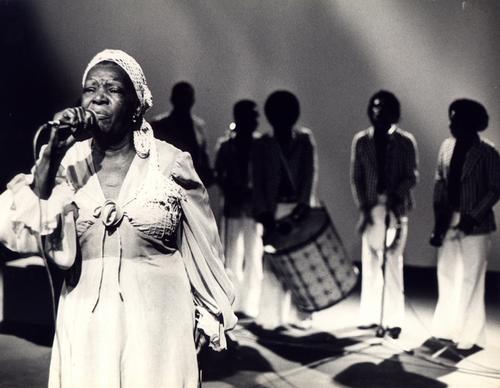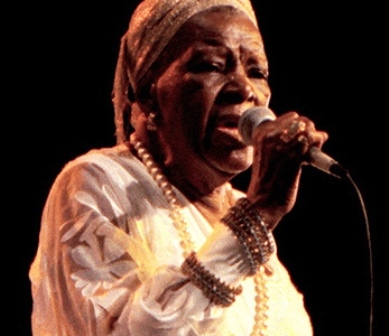
October 10, 2014
CLEMENTINA DE JESUS
In the tradition of Bessie Smith, Clementina de Jesus was one of Brazil’s greatest symbols of black cultural history
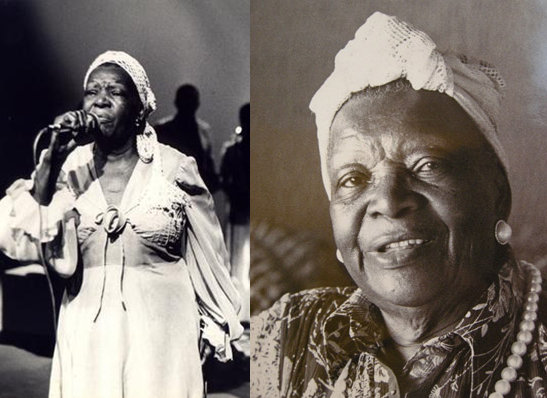
Note from BW of Brazil: Needless to say, today’s post is an homage and an article that has been long overdue. The sound of Samba is as important to the cultural history of Brazil as Blues or Jazz are to the United States, Son is to Cuba or Merengue is to the Dominican Republic. One could argue that it is simply not possible to fully understand Brazilian popular culture with studying the Samba and Clementina de Jesus embodied in her style and sound an important link of Brazil to Mother Africa, the nation’s slave past and the historical influence of African descendants. It’s a shame that “Mother” Clementina only began to record professionally so late in her life (her first solo LP was recorded in 1966) but as many of today’s singers will affirm, the few recordings she left behind are a treasure chest representing a rare legacy in Brazilian History. Her very voice and presence represented the struggle of black Brazilian women. There is so much that could be said about the woman that many compare to the great American Blues singer Bessie Smith, but for now, enjoy this introduction and a few videos featuring the woman who was known as Quelé or simply Tina.
Call her Quelé or Tina, Clementina de Jesus was one of black Brazil’s greatest voices
Courtesy of Portal do Arruda
Clementina de Jesus was born in the Carambita community, of Valencia, Rio de Janeiro, on February 7, 1902 (1). While still a young girl, she accompanied her mother, with the task of lighting her pipe, washing clothes, smoked. While washing, mother Amélia sang lundus, jongos, corimas, modas, incelenças, pontos, chulas and cantos de trabalho(work songs), that her daughter kept in her memory and would record 50 years later.
She moved with her family to the capital city at eight years of age to the neighborhood of Oswaldo Cruz. There she has closely followed the emergence and development of the Portela Samba School.
A diamond in the rough. This is how one could define this singer that began her professional career at 48 years of age, having worked for over twenty years as a maid in the house of the same family who liked to listen to her as she washed, ironed or prepared food, with the exception of the lady of the house who said her voice irritated her like a cat meowing.
Her hoarse, almost spoken song was outside of any aesthetic standard and to this day without any parallel among Brazilian singers. Soulmates, not for the repertoire but by the wild manner and the way of integrating voice and body, which freed themselves with all kinds of dance, she can be compared to African-American singers like Bessie Smith.
In this way African ancestry allowed her to establish a bridge of the rich folklore of the terreiros (2) with urban and contemporary language. Clementina was the portrait of Brazilian syncretism. From the prayers in gêge e nagô and songs in Yoruba that she heard from her mother and Catholic hymns that she sang in the church choir; from the points of (Afro-Brazilian religion) Candomblé and sambas de roda (3) of the parties in which she participated.
In 1963 he was invited by Hermínio Bello de Carvalho, who had heard her earlier at a party, and took the stage at Teatro Jovem in Botafogo, opening the Menestrel movement, that united scholars with regular people.
The scholar who accompanied Clementina was the guitarist Turíbio Santos.
The impact was enormous, and inspired Carvalho to follow up. The musical Rosas de Ouro was created. In it, Clementina performed opposite to the Teatro de Revista singer Araci Cortes and had as accompaniment young talents such as as Paulinho da Viola, Elton Medeiros and Nelson Sargento, among others.
Clementina de Jesus didn’t go to school to learn vocal technique, but learned to sing, or rather, developed his song during day to day work. Tina or Quelé or as she was called by her friends, recorded throughout her career 9 LPs and 3 mini albums and participated in albums of other artists such as Milton Nascimento.
This wonderful Afro-Brazilian also performed in Africa and Europe. She even sang the Marseillaise, the French national anthem in France itself. She didn’t sell a lot of albums and as music critic Carlos Calado said, “Ironic and sad, but in some countries the imitation jewelry is worth more than the rough diamonds.”
Considered the queen of partido alto style, with the unmistakable timbre of her voice, she was honored by Elton Medeiros with the partido “Clementina, Cadê Você?” (Clementina, Where Are You?) and by Clara Nunes with “PCJ, Partido Clementina de Jesus” in 1977 by the Portela composer Candeia.
Rainha Ginga, Quelé, Tina, ways to of referring to Clementina de Jesus, with the imposing title of royalty and with the affectionate corruption of her name.
The tenderness of an old smiling black woman. Everyone who was involved with her had the urge to call her Mãe (Mother), as the musicians of the musical Rosa de Ouro called her. A special sparkle in her eyes that captivated the humblest to Emperor Haile Selassie.
Tina or Quelé, died in July 1987 at age 85, leaving an emptiness but the memory of a race recorded for future generations.
Documentary about Clementina de Jesus shown free in Bahia
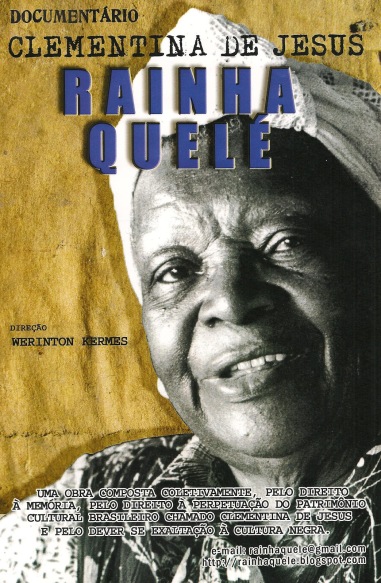
Film tells the story of one of the most important black voices of Brazil.
by Ingrid Maria Machado
Testimonials of Martinho da Vila, Leci Brandão, Paulinho da Viola, João Bosco, Carlinhos Vergueiro, Mônica Salmaso and Cristina Buarque, all greats of Brazilian music, punctuate the documentary Clementina de Jesus – Rainha Quelé, which received a free special showing on Tuesday (March 6, 2012), in Cineteatro Solar Boa Vista, in the Brotas neighborhood of Salvador, Bahia. The showing celebrated the commemorations of women’s day. Also involved in the event were various members of the Movimento Negro (black movement) of Bahia.
“Clementina de Jesus is an example of a woman who needs to be appreciated, disseminated. Black, poor, a maid, a mother, and who achieved visibility, national and international respect singing, making art in her way, with her striking, throaty voice, with its simplicity. Nothing more fair than a cultural space, such as the Solar, located in a neighborhood with peripheral features, reminiscent of the senzalas (slave quarters), renders homage to Rainha Quelé, to Ms. Clementina de Jesus and hence the black women who construct the everyday of this place,” Boa Vista coordinator, Chico Assis.
“The documentary is beautiful, I was very emotional me when I saw it. I had to do it so that more people saw the story of Clementina” – Chico Assis
Clementina de Jesus
Black, poor, housewife, maid and one of the most exuberant figures in Brazilian popular music. As such was Clementina de Jesus, born in 1901 in the city of Rio de Janeiro. It was in the capital of Rio that the black woman with the striking voice was discovered musically in 1963 by poet, songwriter and cultural producer Hermínio Bello de Carvalho.
With him, she visited several places in Brazil, raising her voice on the show ‘Rosa de Ouro’. The artist made a question of respecting her ancestry and took to concerts and television programs, a bit of reference she had in Africa and Afro-Brazilian culture. She recorded five solo LPs, and participated in several others, such as Fala Mangueira, recorded in 1968, which had Cartola as another of the special participants.

Names such as João Bosco, Milton Nascimento, Alceu Valença and Clara Nunes, among so many other great personalities of Brazilian popular music always respected, recording or singing Clementina.
Directed by Werinton Kermes and screenplay by Miriam Cris Carlos the film was awarded for Best Feature Film at the Festival Internacional de Cinema de Arquivo REcine. 2011 made 25 years of her death, which was caused by a stroke.
Clementina de Jesus documentary — Rare Scenes
TV Votorantim – Mayara Cruz – Clementina de Jesus Documentary (2011)
Clementina de Jesus – “Marinheiro Só” (1982)
TV Cultura – Clementina de Jesus “Me Da Meu Boné”
Source: Portal do Arruda, G1
Notes
1. Some sources list her year of birth as 1900 or 1901.
2. Temples or houses of worship for followers of Afro-Brazilian religions.
3. The roda de samba (samba circle) is a very common manifestation in the cities of Rio de Janeiro and São Paulo, Brazil. Rodas de samba are like Jazz jam sessions. Rodas de samba do not require large financial contributions and often bring together a lot of people singing and dancing around a table, where the musicians play instruments and sing. The roda de samba has its own characteristics: a real samba does not require microphones and not even a certain number of people to play it, it’s free from any liability to do it right. Everyone within or outside of the roda or can give their opinions on the songs to be played. Source
The two videos below feature the participation of Clementina de Jesus in rodas de samba, along with several other greats of Samba.
Roda de Samba featuring Candeia, Dona Ivone Lara and Clementina de Jesus
Roda de Samba featuring Clementina de Jesus

